How to Determine if an Element is in the Viewport and Its Applications in Front-End Development
- 476Words
- 2Minutes
- 03 Sep, 2024
In front-end development, determining whether an element is in the viewport (i.e., within the user’s visible area) is a common and critical requirement. Whether it’s implementing lazy loading for images, triggering specific animations, implementing infinite scrolling, or tracking ad exposure, this technique can significantly enhance page performance and user experience. This article will introduce several methods to determine if an element is in the viewport and demonstrate their application scenarios in actual development.
1. Using the Intersection Observer API
The Intersection Observer API is one of the powerful tools provided by modern browsers to asynchronously detect whether a target element is in the user’s viewport. It’s not only efficient but also capable of adapting to complex view scenarios.
Example Code:
1// Create an Intersection Observer instance2const observer = new IntersectionObserver((entries) => {3 entries.forEach((entry) => {4 if (entry.isIntersecting) {5 console.log("Element is in view!");6 // Once the element is in view, you can perform lazy loading of images or trigger animations here7 }8 });9});10
11// Select the element to be observed12const targetElement = document.querySelector("#target");13observer.observe(targetElement);2. Using the getBoundingClientRect Method
The getBoundingClientRect method can directly obtain the size of an element and its position relative to the viewport. By combining it with window.innerHeight and window.innerWidth, you can determine whether the element is in the viewport.
Example Code:
1function isElementInView(element) {2 const rect = element.getBoundingClientRect();3 return (4 rect.top >= 0 &&5 rect.left >= 0 &&6 rect.bottom <=7 (window.innerHeight || document.documentElement.clientHeight) &&8 rect.right <= (window.innerWidth || document.documentElement.clientWidth)9 );10}11
12const targetElement = document.querySelector("#target");13
14window.addEventListener("scroll", () => {15 if (isElementInView(targetElement)) {16 console.log("Element is in view!");17 // Perform the required operation here18 }19});3. Using Third-Party Libraries
Besides using native methods, you can also leverage third-party libraries to implement this feature. Libraries like Lazysizes and Waypoints provide convenient tools to detect whether an element is in the viewport and often integrate additional functionalities such as lazy loading and animation triggers, helping developers quickly achieve complex requirements.
Practical Application Scenarios
1. Lazy Loading Images
Load images only when the user scrolls to a certain image area, which can significantly reduce the initial page load time and bandwidth consumption.
1if (isElementInView(imageElement)) {2 imageElement.src = imageElement.dataset.src; // Replace image src to implement lazy loading3}2. Animation Effects
Trigger CSS animations or other effects when the element enters the viewport.
1if (isElementInView(animatedElement)) {2 animatedElement.classList.add("animate");3}3. Infinite Scrolling Content
Automatically load more content when the user scrolls to the bottom of the page.
1if (isElementInView(loadMoreTrigger)) {2 loadMoreContent();3}4. Ad Exposure Tracking
Send exposure tracking data when the ad element enters the user’s viewport.
1if (isElementInView(adElement)) {2 trackAdExposure(adElement);3}Conclusion
Determining whether an element is in the viewport has widespread applications in front-end development, from lazy loading to animation triggering, infinite scrolling to ad exposure tracking. Mastering these methods and techniques can significantly improve page performance and user experience. Choosing the right approach for different scenarios can help you complete development tasks more efficiently.

